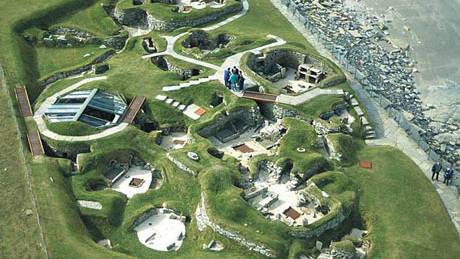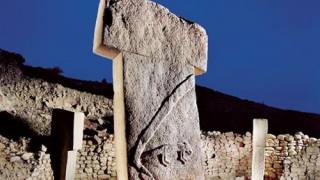Megalithic pint, anyone?
Source: entertainment.timesonline.co.uk
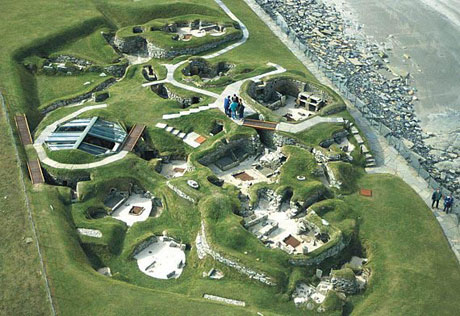
Skara Brae in Orkney
Could it be that the story of man, as commonly told, is based on a false premise? Archaeologists assume a smooth progression in human development from primitive hunter-gatherers to sophisticated city dwellers. But this cosy theory has been undermined by the work of a professor of engineering. Alexander Thom is credited with the discovery that structures left by late Stone Age man were built to a standard unit of measurement so precise that he could identify its original value to an accuracy less than the width of a human hair.
Thom died in 1985 without ever being able to explain the origin of what he called the “megalithic yard”. Our quest has led us to the answer; in the process we have opened a treasure chest of lost knowledge leading us to conclude that in prehistory there was a highly advanced intelligence at work.
It is an incontestable fact that on the western fringes of Europe, from parts of Scandinavia and the Baltic down to northern Spain and throughout the British Isles, an ancient people created huge circles and other structures using stones weighing up to 350 tonnes. The 20m (65ft) high Le Grand Menhir Brisé in Brittany is an example, while on the banks of the River Boyne in Ireland they left a massive circular structure now known as Newgrange, a thousand years older than the Great Pyramid in Egypt. How was it done?
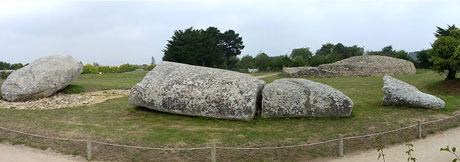
Le Grand Menhir Brisé in Brittany
Thom realised that prehistoric builders had a significant interest in astronomy, and that many of the larger sites have solar, lunar and stellar alignments. From the Ring of Brodgar in Orkney to Stonehenge in southern England and to the stone rows of Brittany, it was clear that these people spent a lot of time observing the movements of the heavens. Newgrange, for example, has a single shaft that was carefully constructed to allow the light of Venus to penetrate into a central chamber once every eight years, giving the engineers who designed the observatory a calendar so accurate that it can be beaten today only by the use of atomic clocks. Even more surprisingly, it appeared that most of these prehistoric sites, from the island off northern Scotland down to the coast of Brittany, had been constructed using a standard unit of measurement — Thom’s megalithic yard, equal to 82.96656cm.

Ring of Brodgar in Orkney
Thom’s work is still largely ignored because it is inconsistent with scholarly opinion of the abilities of prehistoric man. Thom, who was professor of engineering at Oxford University from 1945 until 1961, could not explain his findings. He was aware that even if there had been a priesthood who cut poles to the required length and then passed them on over the tens of thousands of square miles involved and across many generations, such uncanny accuracy could not have been the result. The only hope of resolving the issue was to attempt to identify a methodology for reproducing such a length at different locations.
Our shortlist of possibilities for any naturally occurring unit of measure came down to just one candidate: the turning of the Earth on its axis which enabled early man to measure the passing of time. But how could a unit of time be converted into a linear unit? We eventually realised that the answer lay in pendulums.
At the heart of the traditional clock lies the pendulum. The wind-up spring or electrical motor is merely a mechanical device to provide a power source to keep the pendulum swinging rather than have it swing by hand. And the dial on the clock-face is simply a convention to give us a standardised means of reading off agreed units of time. When we stripped away the modern aspects of a mechanical clock we realised that it is, in essence, nothing more than a swinging pendulum.
We could imagine that a hypothetical prehistoric clock could work perfectly well without a clockwork mechanism or a dial. All we needed to create such a timepiece was for two of us to take turns to swing a pebble on the end of a piece of twine with our hands while the other counted off groups of completed beats. For example, a small stone could be put in a line for every hundred beats. This “man-clock” would work well enough to allow for accurate astronomical calculations to be carried out over several days if necessary.
Further research established to our satisfaction that our megalithic ancestors calibrated their pendulum by observing the planet Venus.When the experiment is undertaken in Orkney, where some of the most magnificent of the megalithic monuments are to be found, the size of the resulting pendulum is very significant. The pendulum proved to be half a megalithic yard, the full length of which deviated from Thom’s findings by a staggering one part in 2,700. Allowing for the human factor (that someone has to hold the pendulum and decide when to start and stop it), the Venus-based half-megalithic yard pendulum is perfect. Our result is within the very fine margin of error identified by Thom.
This method of reproducing the megalithic yard was so simple it was not necessary for the master mason to have the ability to count the number of beats in any modern sense. Counting does not have to be part of a tiered system such as the base ten method used today, in which we notch up in multiples of ten by adding a nought after the digit. A nursery rhyme or a sea shanty is a good way of counting out a set number while pointing at a sheep for each word will tell you whether your flock is still intact:
“Eeny, meeny, miney, mow, catch a monkey by the toe. If he squeals let him go. Eeny, meeny, miney, mow.”
It follows that measuring something as simple as this could be old as language itself. Indeed, the words “eeny, meeny, miney, mow” are thought to be an ancient British counting technique from more than 4,000 years ago.
Having established the method for “proving” the megalithic yard, we took another step forward and began to construct a theoretical weight and capacity system. We began at the point in history at which many more modern cultures appear to have started when creating such units; by making a cube with sides of an equal length and filling it with water. We knew that those creating the metric system had opted for a length of one tenth of a metre, which they cubed. The volume of water in such a 10 x 10 x 10cm cube was designated a litre, and the weight of such a body of water was named a kilogram
In our case, the linear units would have to be in megalithic inches, which Thom identified as being one 40th of a megalithic yard, equal to 2.07415cm. Taking his lead from the metric system, we first considered a cube with sides of a tenth of a megalithic yard — i.e. four megalithic inches (MI). In metric terms, this turned out to have a capacity a little over half a litre at 571.08 cubic cm. But as he performed this simple sum on a calculator, my colleague Chris Knight thought he recognised the number produced and he quickly converted it into imperial units (the standard measuring system still used in the UK). Something odd was happening because the theoretical megalithic unit of capacity was equal to 1.005 pints — much nearer to one perfect British pint than any pub landlord achieves when pulling a glass of draught ale.
Next we doubled the length of the side of the cube to eight MI and the shock of the first coincidence was compounded because this calculation produced a capacity of one imperial gallon to the same incredible level of accuracy. A doubling again produced a unit equivalent to an obsolete bushel, which was used as a dry weight until recent times. We realised that the gallon would have to fit the same way as the pint because there are eight pints to a gallon and a doubling of the side of a cube will create a capacity eight times larger. But this fact did not detract from the oddity because the imperial system is not known to be based on cubes.
We soon established that the pint and the gallon had had a variety of values before the standardisation of imperial units in the 19th century, so the correspondence with the megalithic cube might not be meaningful. However, we looked at examples of the pint from earlier periods and found only small variations. One that was almost the same as the imperial pint dated from the reign of Henry VII (1485-1509) and checking this against the four megalithic inch cube showed that it was even closer than the modern pint. It was almost a perfect match, with a deviation of less than one part in 1,000.
Even closer was the standard pint identified for the Exchequer in 1601. To all intents and purposes this Elizabethan pint and the volume of the megalithic inch are the same.
The pint had turned out to be much older than we imagined.
Civilization One: The World is not As You Thought it Was, by Christopher Knight and Alan Butler, is published by Watkins (£16.99; offer £13.59)
Spot the star: a Stone Age riddle
Did Britain once have a “national network” of megalithic observatories, with different locations for varying astronomical purposes? One archaeological site at Skara Brae in Orkney may have been a megalithic “university” for training astronomer priests.
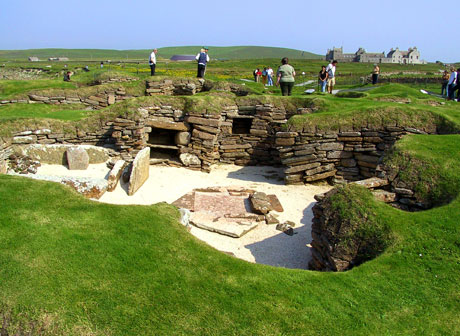
Skara Brae in Orkney
Radio-carbon dating has shown that it was occupied between 3215 and 2655BC when it provided a series of linked rooms. Each room had matching stone-built furniture, including dressers, beds, cooking areas and water tubs for washing.
Archaeologists have identified that secrecy, security and plumbing are also apparent at the site. A hidey-hole has been found under the stone dresser and a hole for a locking bar was located on both sides of doors. The house designated by archaeologists as “number seven” was isolated and its door barred, suggesting that it was designed to house an occupant against his will.
The archaeologist Euan Mackie suggested that Skara Brae was a kind of prehistoric college after noticing that skull remains of sheep and cows eaten there did not match the number of carcasses. He concluded that meat had been imported to the island, along with firewood. Because the island had nothing to trade, the only reasonable answer to this puzzle is that the inhabitants were an elite group supported by a community at a distance
Shakus, cubits and varas
The standard view of history is that the further back in time one looks, the greater will be the disorganisation. In fact, the reverse is the case — the deeper we peer into the past, the greater the harmony.
Archaeology is highly compartmentalised and connections between cultures spaced by time or geography are rarely investigated. The only holistic study we know of is that relating to the development of language, which maps out a tree of connections for more than 6,000 distinct languages. Following the patterns of words that are shared by peoples who have no known connection, experts have concluded that every group of humans in the world once spoke the same language — and that the date of this convergence was as recent as 15,000 years ago. Yet they stop short of asking how such a thing can be true. Surely, if everyone spoke the same language, there must have been a high level of frequent contact between peoples around the world, at a time when, in the modern comprehension of prehistory, this would have been impossible?
But the mysteries go well beyond linguistics. Having detected strong links in the astronomy-based measurement systems used by the Stone Age megalithic people of the region centred on the British Isles with the Minoans on Crete and the Sumerians who lived in what is today Iraq and Kuwait, we wondered whether the same principles had come into play elsewhere in the world.
We found that the Indus Valley civilisation or Harappa culture of the Indian subcontinent, which dates from about 2800BC, had a unit of length called the gaz that is close to the megalithic yard. We dismissed this as a probable coincidence until we became aware of the cube-shaped stone weights that this culture used. These weights correspond almost perfectly to the imperial system. The largest weight is 3lb and one of the smallest is just one four-hundredths of a pound. This was especially interesting as we had already identified that the pound weight is derived from a cube with sides of one-tenth of a megalithic yard (four megalithic inches).
The Spanish vara is close to being a megalithic yard, as is the old Japanese measure known as the shaku. This is believed to have been imported from China more than a thousand years ago — it is almost indistinguishable from the Minoan foot. It follows that 366 megalithic yards is almost the same as 1,000 Japanese shaku, with a fit accuracy of 99.8 per cent.
Looking at Ancient Egypt, we found that the base unit of linear measurement, in use for almost the whole of Egyptian history, was the “royal cubit”. We discovered that the Great Pyramid was built using a measuring wheel with a circumference of one megalithic yard and a diameter of a half royal cubit. The ancient Egyptians also had a principal unit of area called the setat that was most commonly used in its quarter form. As already noted by other researchers, the inner edge of the circle, or Sarsen Ring, at Stonehenge has a diameter of 1,162.8in, which means that it has an area exactly equal to an Egyptian quarter setat.
Coincidence? Possibly — but it seems unlikely when the old unit of length known as the gaz is brought back into the picture. There is no evidence known to us that gives a precise measure for the gaz, but we know it was close to the megalithic yard, which was still in use in Britain when the earliest Indus Valley cities were established. Could international communications have been so advanced as to allow a southern Asian culture to take its measurement system from the megalithic builders of the western fringes of Europe?
CK, AB
